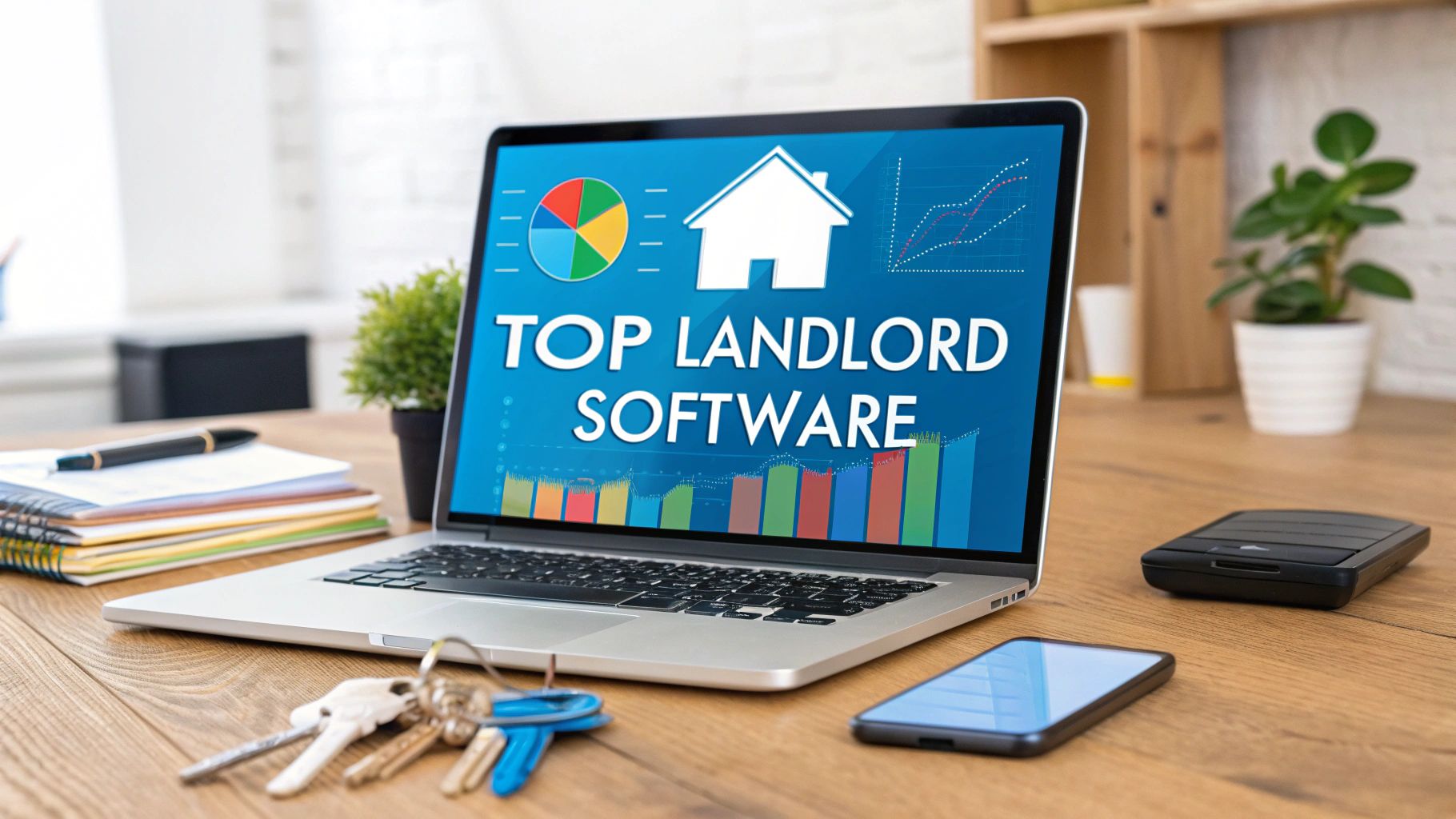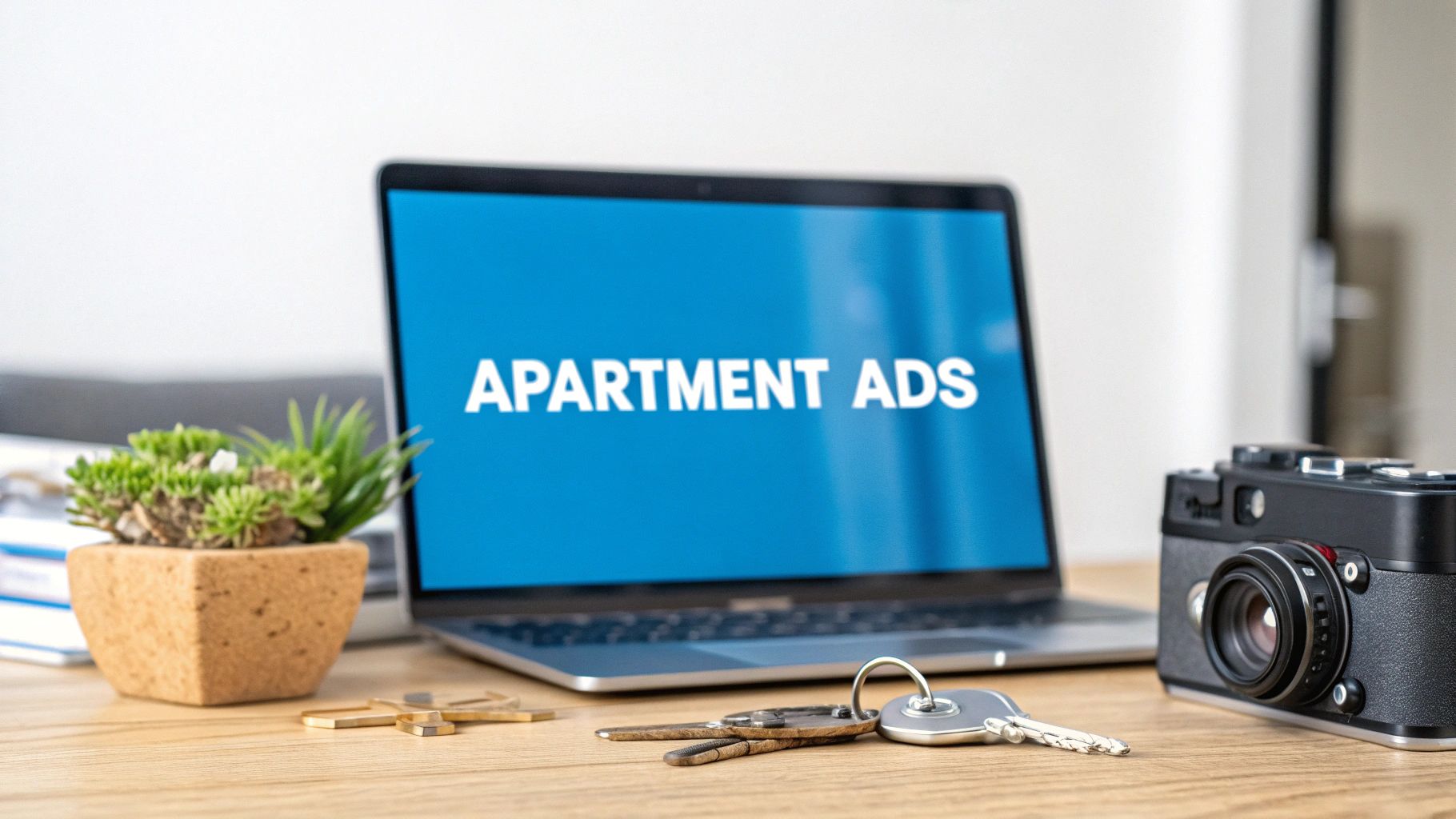For property managers overseeing 100 to 10,000+ units, operational efficiency isn't a luxury; it's the bedrock of profitability. Every vacant day erodes revenue, and slow lead-to-tour conversions are a direct hit to your bottom line. Generic landlord tools simply don't address the unique challenges of managing a distributed portfolio. You need a technology infrastructure built for scale, automation, and remote operations.
This guide moves past basic all-in-one solutions to focus on the best software for landlords obsessed with critical metrics like Days on Market (DOM) reduction and cost-per-door optimization. For example, a 5-day reduction in DOM across a 1,000-unit portfolio with an average rent of $1,800/month can recover over $300,000 in annual revenue. While those just starting out can build a strong foundation with essential first-time landlord tips, scaling a large portfolio requires a more sophisticated tech stack.
We will analyze 12 leading platforms, complete with screenshots and direct links, to help you make an informed decision. We'll categorize each solution by its best use case for enterprise-level challenges, from full-stack Property Management Systems (PMS) to specialized leasing automation tools that directly impact your speed-to-lease and financial performance. This resource is designed to help you identify the right systems to standardize processes, enhance remote management, and ultimately drive revenue across your entire portfolio.
1. Showdigs
Best For: Large-scale property management companies and operators focused on optimizing the leasing funnel for scattered single-family rentals (SFRs) and multi-family units without on-site staff.
Showdigs stands out as the premier leasing automation platform, meticulously engineered to solve the complex challenges of managing geographically dispersed rental portfolios. It goes beyond typical software by integrating sophisticated AI-backed automation with a network of on-demand, licensed real estate agents. This powerful combination directly addresses the core pain points of large-scale operators: reducing Days on Market (DOM), boosting lead-to-tour conversion rates, and standardizing leasing operations across multiple markets. For property managers obsessed with operational efficiency and revenue impact, Showdigs provides a scalable framework to accelerate the entire leasing process, from initial inquiry to a signed lease.
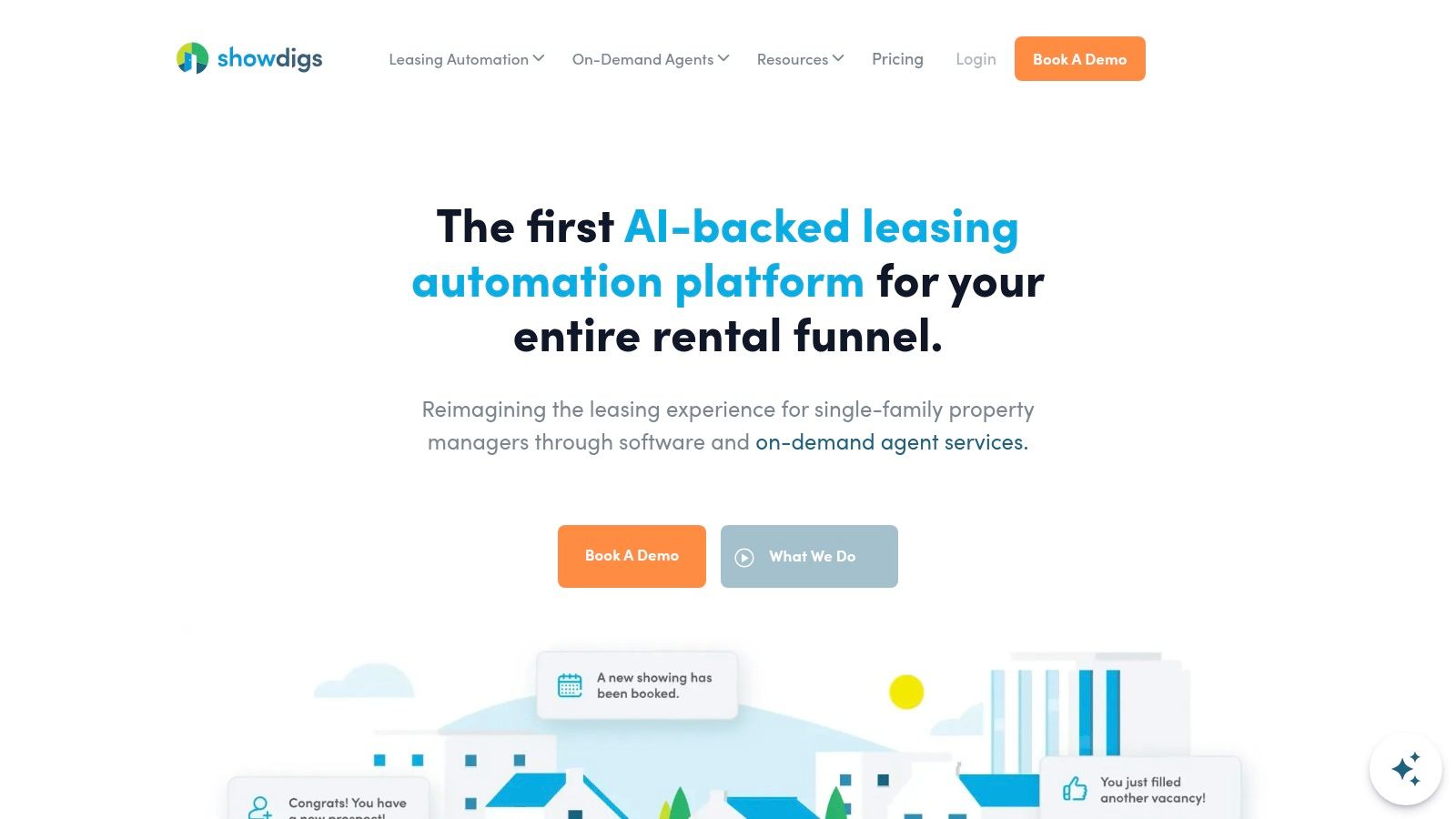
The platform’s core strength lies in its ability to offer immediate and flexible showing options. Prospective tenants can choose self-guided tours using smart lock technology, schedule virtual tours, or request an in-person tour with a local Showdigs Agent. This multi-channel approach ensures no lead is lost due to scheduling conflicts, a critical factor in a competitive rental market where, according to Zillow, 46% of renters want to tour a property within 24 hours of finding it. Its seamless API integration with major property management systems like Appfolio and Yardi makes it an easy addition to an existing tech stack, automating lead communication, scheduling, and follow-up without disrupting established workflows. This makes Showdigs an essential tool for any landlord looking for the best software to streamline operations and enhance portfolio performance.
Key Features & Benefits
- Hybrid Automation & Human Touch: Uniquely combines AI-driven scheduling and communication with a network of licensed agents for in-person showings, offering unparalleled flexibility. This system is purpose-built for remote management of scattered-site portfolios.
- Drastic DOM Reduction: By enabling same-day and on-demand tours, Showdigs directly shortens the leasing cycle. This speed-to-lease is crucial, as every vacant day represents lost revenue, a significant metric for large portfolio owners.
- Seamless PMS Integration: Native API integrations with platforms like Appfolio, Yardi, and Buildium ensure that lead data, tour schedules, and feedback sync automatically. This eliminates manual data entry and streamlines operational workflows for property managers.
- Comprehensive Field Services: Beyond showings, Showdigs Agents can conduct detailed move-in/out condition reports, routine inspections, and place lockboxes, providing a complete, on-the-ground solution that reduces the need for in-house staff.
Pricing & Availability
Showdigs operates on a subscription-based model, with pricing tailored to portfolio size and service needs. Specific costs are provided after a personalized demo, ensuring the plan aligns with your operational scale and goals. While the on-demand agent network is available in select major metropolitan areas, the self-showing technology and software platform are available nationwide, offering a scalable solution for any market.
Pros & Cons
2. AppFolio Property Manager
Best For: Enterprise-grade platform for mid-sized to large property management companies with diversified portfolios.
AppFolio Property Manager is a powerful, enterprise-grade platform built for scale, making it one of the best software solutions for landlords managing mid-sized to large, diversified portfolios. It excels in providing a unified system for residential, commercial, and community association properties, a key differentiator for professional managers. The software centralizes everything from marketing and leasing to accounting and maintenance, driven by robust workflow automation and AI-powered tools designed to improve operational efficiency.
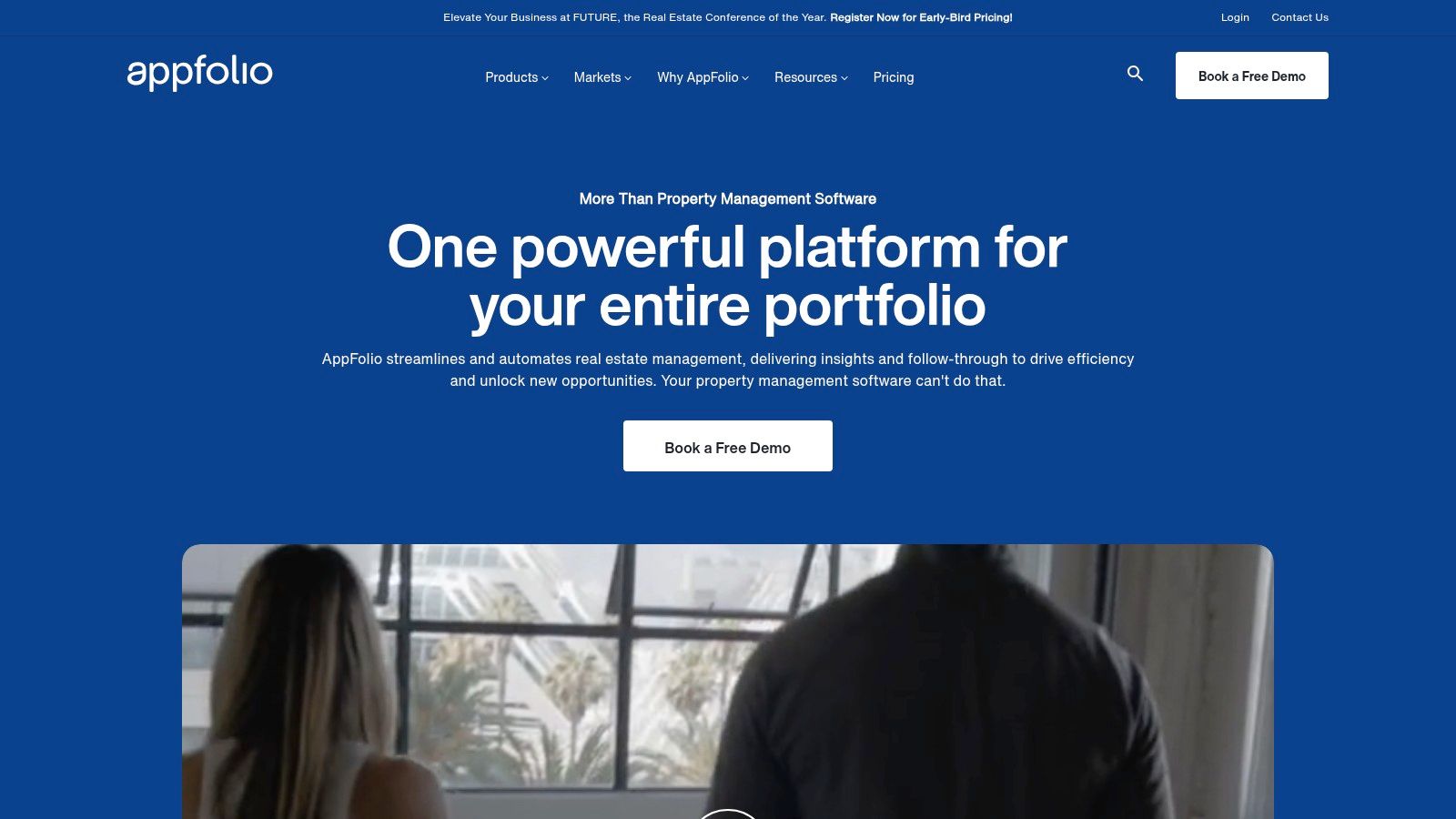
This platform is not for the small-time landlord; its architecture is designed to optimize cost-per-door and streamline remote operations across hundreds or thousands of units. The user experience is mature, with dedicated portals for residents and owners that enhance communication and self-service capabilities.
Key Features & Use Cases
- Portfolio Type: Best for professional property management companies with 50+ units, especially those with mixed portfolios (residential, commercial, student housing, HOA).
- Standout Feature: AppFolio's advanced accounting and reporting capabilities are a significant advantage for large-scale operations. It handles complex tasks like CAM reconciliations and corporate-level financial reporting with ease.
- Pricing: Pricing is not publicly listed and requires a custom quote. It follows a per-unit, per-month model with a monthly minimum fee (typically around $280/month), making it cost-prohibitive for smaller portfolios. Be aware of additional onboarding fees and charges for add-on services like advanced screening or payments.
Pros & Cons
Pros:
- Highly Scalable: Built to handle the complexity of large, multi-market portfolios.
- Comprehensive Toolset: True end-to-end functionality eliminates the need for multiple disparate systems.
- Powerful Automation: Advanced workflows and AI features significantly reduce manual administrative tasks, a key benefit for improving cost-per-door metrics.
Cons:
- High Cost of Entry: The per-unit pricing structure and significant monthly minimums are not suitable for landlords with few properties.
- Opaque Pricing: You must contact sales for a quote, and extra fees for implementation and certain services can add up.
Visit AppFolio Property Manager
3. Buildium
Best For: A well-rounded platform for managers of small-to-large residential portfolios seeking scalable features.
Buildium is a veteran in the property management software space, offering a well-rounded, all-in-one platform ideal for a wide range of residential landlords and professional managers. It strikes a balance between comprehensive features and user-friendly design, making it a strong contender for those managing small-to-large residential portfolios and associations. The platform provides a unified solution for accounting, maintenance, resident communications, and leasing, all underpinned by transparent, tiered pricing plans.
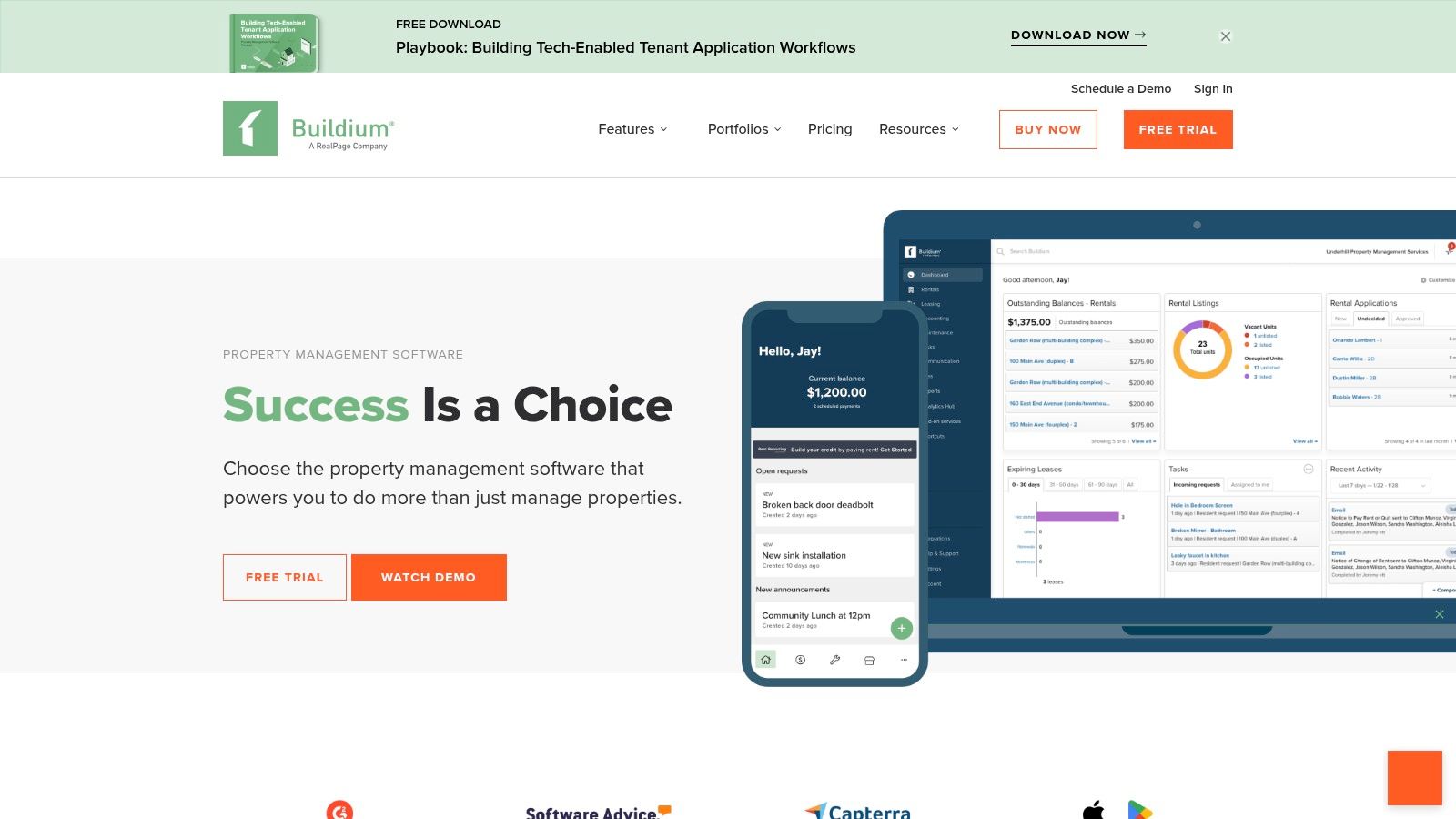
Unlike platforms targeting exclusively large-scale enterprises, Buildium offers accessible entry points for smaller portfolios while still providing the tools needed to scale. Its strong support for community associations (HOAs) and excellent training resources make it a standout choice for managers who value both functionality and robust customer support. This makes it one of the best software for landlords who are growing their operations.
Key Features & Use Cases
- Portfolio Type: Best for residential property managers with 1 to 5,000 units, including strong support for community and homeowner associations (HOAs).
- Standout Feature: The tiered plan structure (Essential, Growth, Premium) is a key differentiator. It allows property managers to select a feature set that matches their current scale and budget, with clear upgrade paths for advanced analytics, e-signatures, and API access as their portfolio grows. You can learn more about Buildium's features here.
- Pricing: Buildium offers transparent monthly pricing based on the number of units managed. Plans start with the Essential tier and scale up to Growth and Premium, which unlock more advanced features. Be mindful that lower-tier plans may have additional fees for services like electronic payments, bank account setups, and e-signature allotments.
Pros & Cons
Pros:
- Transparent Pricing Tiers: Clear, public pricing makes it easy to budget and compare plans, with a free trial available.
- Excellent HOA Support: Robust features specifically designed for managing community associations and HOAs.
- Strong Support & Training: Widely recognized for its helpful customer support and extensive library of training resources.
Cons:
- Ancillary Fees: Lower-cost plans can incur extra fees for services that are included in higher tiers, such as EFT transactions.
- Advanced Tools are Gated: Critical tools for scaling, like Open API access and performance analytics, are reserved for the most expensive Premium plan.
4. Yardi Breeze (and Breeze Premier)
Best For: Growing portfolios that need a scalable platform from a trusted industry leader.
Yardi Breeze brings the power of an industry-leading property management software brand to small and mid-sized portfolios. It offers a streamlined, cloud-based solution that is refreshingly easy to use, making it some of the best software for landlords who are growing but not yet at an enterprise scale. The platform is designed for accessibility, providing core functionalities for marketing, leasing, accounting, and resident management without the complexity of its larger sibling, Yardi Voyager.

The key appeal of Yardi Breeze is its scalability. Landlords can start with the basic Breeze plan and seamlessly upgrade to Breeze Premier as their portfolio or operational needs expand. This provides a clear growth path within a single ecosystem, avoiding the pain of data migration between disparate systems as your company scales.
Key Features & Use Cases
- Portfolio Type: Ideal for independent landlords and small to mid-sized property management companies (1 to 500+ units) across residential, commercial, and other property types.
- Standout Feature: The clear upgrade path to Breeze Premier and eventually Yardi Voyager is its greatest strategic advantage. This allows businesses to invest in a platform that grows with them, from managing a few doors to thousands, all backed by Yardi's robust accounting foundation.
- Pricing: Yardi Breeze offers transparent, per-unit pricing. The standard Breeze plan starts at $1 per unit per month, with a $100 monthly minimum. Breeze Premier, which adds more advanced features like job cost tracking and corporate accounting, starts at $2 per unit per month with a $400 monthly minimum.
Pros & Cons
Pros:
- Scalable Solution: Provides a direct and easy upgrade path from a basic to a more advanced system (Premier).
- Strong Accounting Core: Leverages Yardi's renowned, compliance-focused accounting engine, a major plus for financial management.
- Transparent Pricing: The clear per-unit cost and monthly minimums make it easy to budget for, unlike systems that require custom quotes.
Cons:
- Monthly Minimums: The $100 or $400 monthly minimum can be a hurdle for landlords with very few properties.
- Add-on Costs: Key services like tenant screening are not included in the base price and will increase the total monthly cost.
5. DoorLoop
Best For: Growing firms that require a modern, user-friendly interface with strong accounting features.
DoorLoop positions itself as a modern, all-in-one platform that is powerful yet surprisingly easy to use, making it one of the best software for landlords who want comprehensive features without a steep learning curve. It’s designed to scale from independent landlords with a single unit to growing property management firms, offering a clean interface and robust functionality. The platform covers the entire property lifecycle, from marketing and tenant screening to accounting and maintenance management.
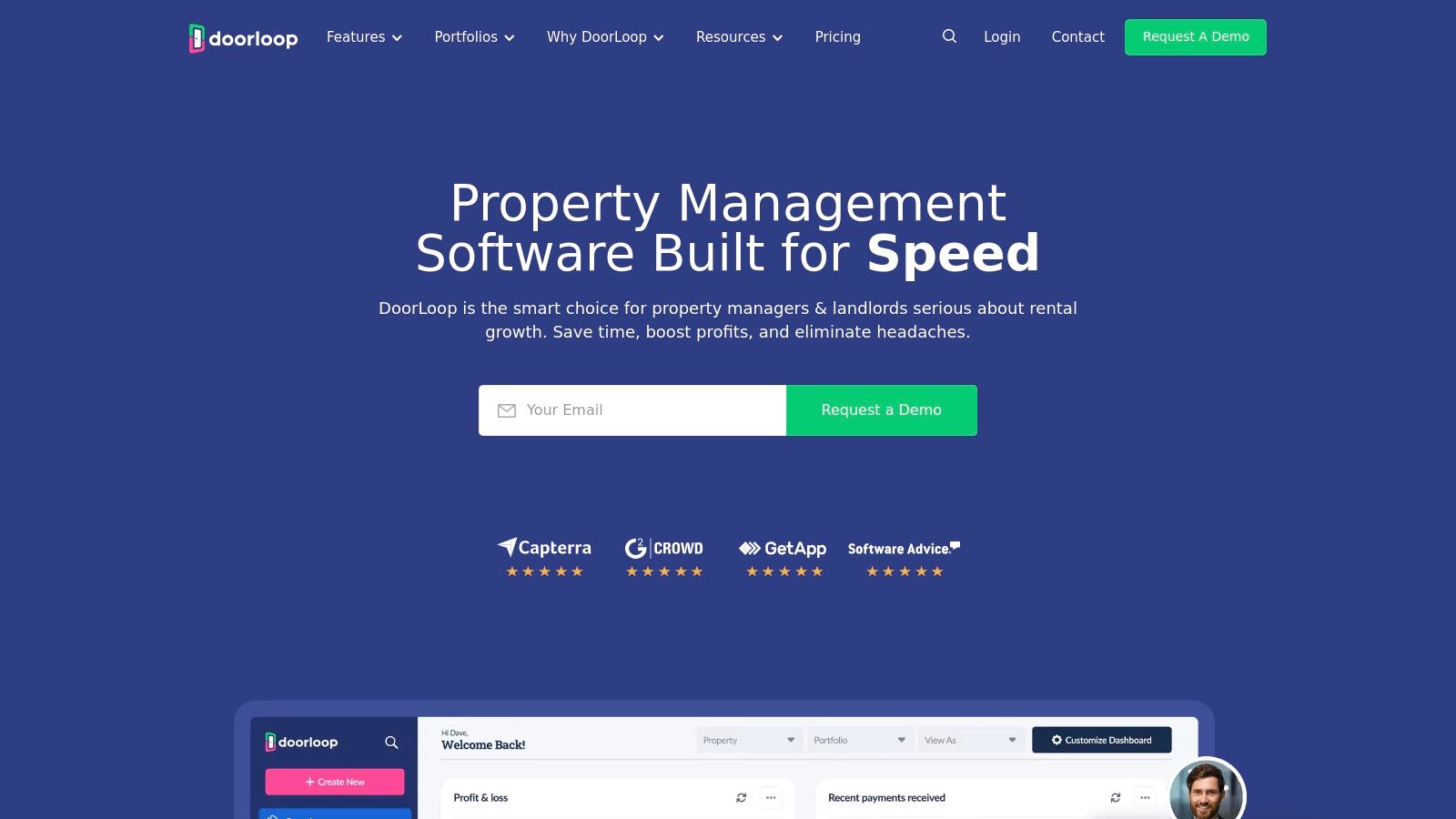
What sets DoorLoop apart is its focus on user experience and accessible support, making complex tasks feel manageable. Its built-in accounting suite with QuickBooks Online synchronization and an open API on its premium tier provide the flexibility needed for operators looking to build an integrated tech stack. By combining a wide feature set with straightforward pricing, DoorLoop is a strong contender for those prioritizing ease of implementation and use. For those interested in integrating such tools into a broader strategy, you can find more information about marketing automation for your leasing tech stack.
Key Features & Use Cases
- Portfolio Type: Best for landlords and property managers with 1 to 1,000 units, including mixed portfolios of single-family, multifamily, and commercial properties.
- Standout Feature: The platform’s comprehensive, built-in accounting system is a major plus. It includes a full chart of accounts, bank reconciliations, and direct sync capabilities with QuickBooks, which simplifies financial management without requiring external software.
- Pricing: Starts at $59/month for up to 20 units on the Starter plan when billed annually. Higher tiers (Pro and Premium) unlock more advanced features like owner portals, user roles, and an open API. Onboarding fees are required and vary based on portfolio size.
Pros & Cons
Pros:
- User-Friendly Interface: The software is frequently praised for its intuitive design, reducing the time needed for training and onboarding.
- Comprehensive Feature Set: Even the base plan includes critical tools for rent collection, maintenance, and accounting.
- Excellent Customer Support: Known for responsive and helpful support across multiple channels, a key benefit for managers who need quick resolutions.
Cons:
- Mandatory Onboarding Fees: While common in the industry, the required implementation fee is an extra upfront cost to consider.
- Tiered Feature Access: Some advanced features, like API access and advanced reporting, are reserved for the more expensive Premium plan.
6. TurboTenant
Best For: DIY landlords and those with small portfolios prioritizing cost-efficiency and essential features.
TurboTenant is one of the best software for landlords who are self-managing a small portfolio and prioritize cost-efficiency above all else. Its primary draw is a robust free-for-landlords model, covering the essential functions of marketing, tenant screening, and rent collection for an unlimited number of properties. The platform syndicates vacant unit listings to major rental sites, streamlining the process of finding qualified tenants without an upfront investment.

This platform is engineered for the DIY landlord managing one to ten properties. It provides professional-grade tools like state-specific lease agreements and electronic signing, which are typically found in more expensive software. The user experience is straightforward, designed to get a new landlord up and running quickly with minimal technical knowledge.
Key Features & Use Cases
- Portfolio Type: Ideal for independent DIY landlords managing 1-10 units who need core management tools without a monthly subscription fee.
- Standout Feature: The "free-to-the-landlord" model is its defining characteristic. Essential services are paid for by the applicant (screening fees) or through optional landlord premium upgrades, making it truly free to start and operate.
- Pricing: The core platform is free for landlords. Tenants pay for screening reports ($45-$55). Landlords can optionally subscribe to a Premium plan (around $99/year) for benefits like faster rent payouts, unlimited connected bank accounts, and state-specific lease templates.
Pros & Cons
Pros:
- Truly Free Tier: Supports unlimited properties with essential features like listing syndication, applications, screening, and rent collection at no cost to the landlord.
- Affordable Upgrades: The optional premium plan is very cost-effective and unlocks valuable features like expedited rent payouts and waived ACH fees.
- Excellent Landlord Resources: Offers an extensive knowledge base, state-specific legal guides, and educational content.
Cons:
- Limited Accounting: The integrated accounting tools are basic and lack the depth required for professional financial analysis or large-scale portfolio management.
- A La Carte Costs: While the core is free, accessing certain lease forms and advanced features can require a premium subscription or one-off payments.
7. RentRedi
Best For: Mobile-first landlords seeking a predictable, flat-rate pricing model for unlimited units.
RentRedi positions itself as a mobile-first platform, making it a strong contender for landlords who manage their properties on the go. Its core value proposition is simplicity and predictable costs, offering a flat-rate pricing model that covers unlimited units and tenants. This approach removes the per-unit, per-month fee structure common with other platforms, making it one of the best software for landlords prioritizing budget-friendly, scalable solutions without complex billing.
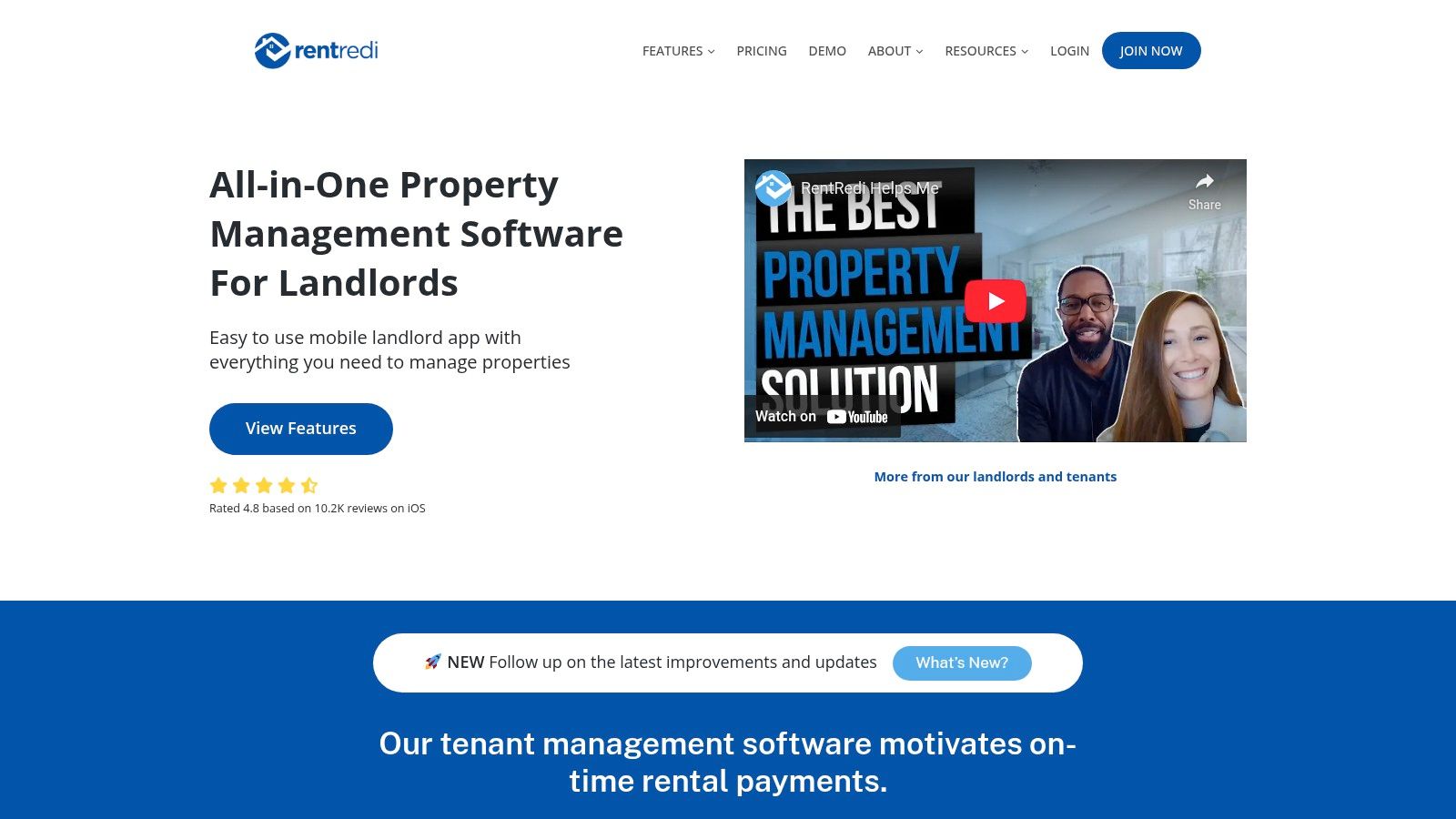
The platform is designed to be landlord-friendly, focusing on core property management tasks like rent collection, tenant screening, and maintenance requests directly from a smartphone. While it may not have the enterprise-level accounting depth of more expensive systems, its integration with QuickBooks and straightforward financial tracking serves the needs of independent landlords and small-to-midsize portfolio managers effectively.
Key Features & Use Cases
- Portfolio Type: Best for landlords with 1-100+ units who want predictable, flat-rate pricing and a mobile-centric management style.
- Standout Feature: The all-inclusive, flat-fee pricing model is a significant differentiator. For a single monthly, quarterly, or annual fee, landlords get access to all core features for an unlimited number of properties, making financial planning simple and scalable.
- Pricing: RentRedi offers straightforward subscription plans, starting at around $12/month when billed annually. Plans are available on a monthly, 6-month, or annual basis, all of which include unlimited properties, tenants, and team members.
Pros & Cons
Pros:
- Budget-Friendly Flat Pricing: The predictable, all-inclusive pricing with no per-unit fees is highly attractive for cost-conscious landlords.
- Strong Mobile Experience: A true mobile-first design allows for efficient management of properties from anywhere.
- Fast Funding Options: Integrates with Stripe to provide landlords with next-day payment options for collected rent.
Cons:
- Less Comprehensive Accounting: While it integrates with QuickBooks, the native reporting and accounting tools are less robust than enterprise-grade systems.
- Occasional Payment Friction: Some users report occasional friction in the payment processing system or delays that require support intervention.
8. Hemlane
Best For: Remote or busy landlords who want to combine software automation with optional on-demand field services.
Hemlane carves out a unique niche in the market by blending property management software with optional, hands-on services. This hybrid model makes it some of the best software for landlords who are remote, busy, or simply want to offload the most time-consuming aspects of management, like maintenance coordination. It provides a core software platform for listings, applications, screening, and financial tracking while offering access to a nationwide network of service professionals.

This platform is ideal for the self-managing landlord who needs more than just software but doesn't want to hire a full-service property manager. The ability to automate repair requests with a 24/7 U.S.-based team is a powerful feature for improving tenant satisfaction and protecting the asset without constant landlord intervention.
Key Features & Use Cases
- Portfolio Type: Best for landlords with 1-100 units who want to automate key operations, especially maintenance, without giving up control of major decisions.
- Standout Feature: The integrated service model is its key differentiator. Landlords can opt into 24/7 repair coordination and access a vetted vendor network, effectively outsourcing maintenance management on a per-property basis.
- Pricing: Hemlane offers a free basic plan for up to 10 units. Paid plans start at $30/month for the core software. The complete package with repair coordination and local agent access starts at $40/month per unit, with pricing tiers that become more cost-effective as you add more properties.
Pros & Cons
Pros:
- Flexible Service Model: Easily scale support up or down, choosing which properties need hands-on maintenance assistance.
- Reduces Landlord Burden: The 24/7 repair coordination service is a major benefit for landlords who want to be hands-off with maintenance.
- Transparent Pricing: Clear pricing tiers and a free entry-level plan make it accessible for smaller landlords.
Cons:
- Service Fees Add Up: While flexible, the per-unit fees for premium services can become costly for larger portfolios compared to traditional software.
- Additional Costs: Services like on-the-ground leasing agent support for showings and tenant placement come at an additional cost.
9. TenantCloud
Best For: Cost-conscious managers scaling from a DIY approach to a mid-sized portfolio.
TenantCloud strikes a compelling balance between affordability and robust features, positioning it as one of the best software for landlords who are scaling from a DIY approach to managing a mid-sized portfolio. A key differentiator is its pricing model, which supports unlimited properties and units on all plans, allowing managers to grow without facing immediate cost-per-door increases. The platform provides a comprehensive suite of tools covering the entire rental lifecycle, from syndicating listings to processing maintenance requests and managing finances.
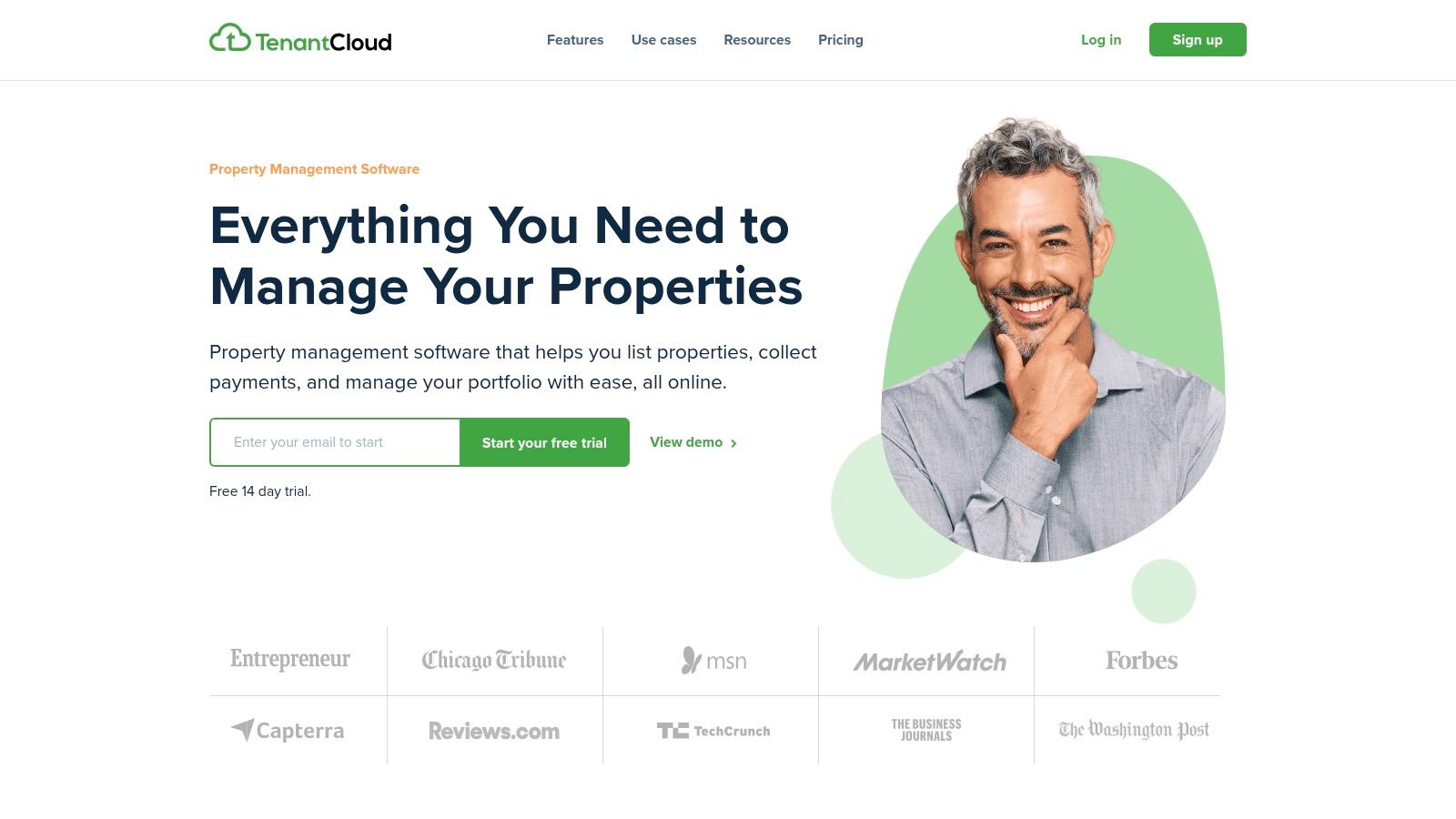
While accessible to smaller landlords, its higher-tier plans introduce features critical for more complex operations, such as team management tools, owner portals for transparent reporting, and QuickBooks Online synchronization. This scalability makes it a viable long-term solution for property managers focused on expanding their portfolio without migrating platforms. The user interface requires some initial setup, but it offers significant depth once mastered.
Key Features & Use Cases
- Portfolio Type: Ideal for DIY landlords up to mid-sized property managers (5-100 units) seeking a feature-rich platform that can grow with them.
- Standout Feature: The combination of unlimited unit support across all pricing tiers and advanced accounting features in the Pro plan (like bank reconciliation and QuickBooks sync) provides unmatched value for cost-conscious, growing portfolios.
- Pricing: Offers a free tier for basic needs. Paid plans start at $15/month for the Starter plan and go up to the Business plan, which requires a custom quote. Higher tiers unlock lower payment processing fees, team management, and advanced financial tools.
Pros & Cons
Pros:
- Highly Competitive Pricing: Unlimited property support on all plans makes it incredibly cost-effective for portfolio growth.
- Scalable Feature Set: Grows with your business, adding robust back-office tools like owner portals and team roles in higher tiers.
- Good Feature Balance: Effectively mixes tenant-facing convenience with essential back-end management and accounting functionality.
Cons:
- Steeper Learning Curve: More initial setup is required compared to simpler, more basic landlord tools.
- Tiered Feature Access: The most valuable features, like the lowest payment fees and advanced accounting, are reserved for more expensive plans.
10. Avail (by Realtor.com)
Best For: DIY landlords with small portfolios who need credible, free tools for core tasks.
Avail is tailored for the DIY landlord managing a small portfolio, from one to a dozen units. Backed by Realtor.com, it offers a surprisingly robust suite of tools on its free "Unlimited" plan, making it one of the best software for landlords just starting out or those who prioritize cost-efficiency over advanced, large-scale features. The platform focuses on simplifying core landlord tasks like listing, screening, and rent collection with an intuitive, guided experience.
The user interface is clean and straightforward, designed to walk landlords through each step of the rental lifecycle without requiring deep property management expertise. Its strength lies in its accessibility and the credibility inherited from the Realtor.com network, which helps syndicate listings to a wide audience of prospective tenants. This makes it an ideal entry point before needing to scale to more complex systems.
Key Features & Use Cases
- Portfolio Type: Best for landlords with 1-15 units who need core functionalities without a monthly subscription fee.
- Standout Feature: The generous free tier is Avail's biggest differentiator. It covers unlimited units for essential services like syndicated listings, credit and criminal screening, online rent collection, and maintenance tracking, which is rare in the market.
- Pricing: The "Unlimited" plan is free. The "Unlimited Plus" plan (around $9/unit/month) adds premium features like waived ACH fees for tenants, faster rent payouts, and the ability to create customized leases and documents.
Pros & Cons
Pros:
- Excellent Free Plan: The free offering covers the essential needs of most small landlords, providing tremendous value.
- Strong Listing Syndication: Leveraging the Realtor.com network gives listings significant visibility on top rental sites.
- User-Friendly: The platform is designed for ease of use, making it simple for non-professionals to manage properties effectively.
Cons:
- Paid Conveniences: Key features that improve cash flow and efficiency, such as next-day rent payments and waived ACH fees, are locked behind the paid plan.
- Limited Scalability: Lacks the advanced accounting, reporting, and portfolio-level analytics needed for managing larger or growing portfolios. For more on this, you can learn more about the tools landlords use at Showdigs.com.
11. Zillow Rental Manager
Best For: Landlords of small portfolios focused on maximizing marketing reach to fill vacancies quickly.
Zillow Rental Manager leverages the immense power of its consumer-facing brand to offer a streamlined, entry-level solution for landlords. It's designed specifically for those managing smaller portfolios who need powerful marketing reach without the complexity of an enterprise system. The platform focuses on the most critical stages of the rental lifecycle: advertising, screening, leasing, and collecting rent, all through a user-friendly interface.
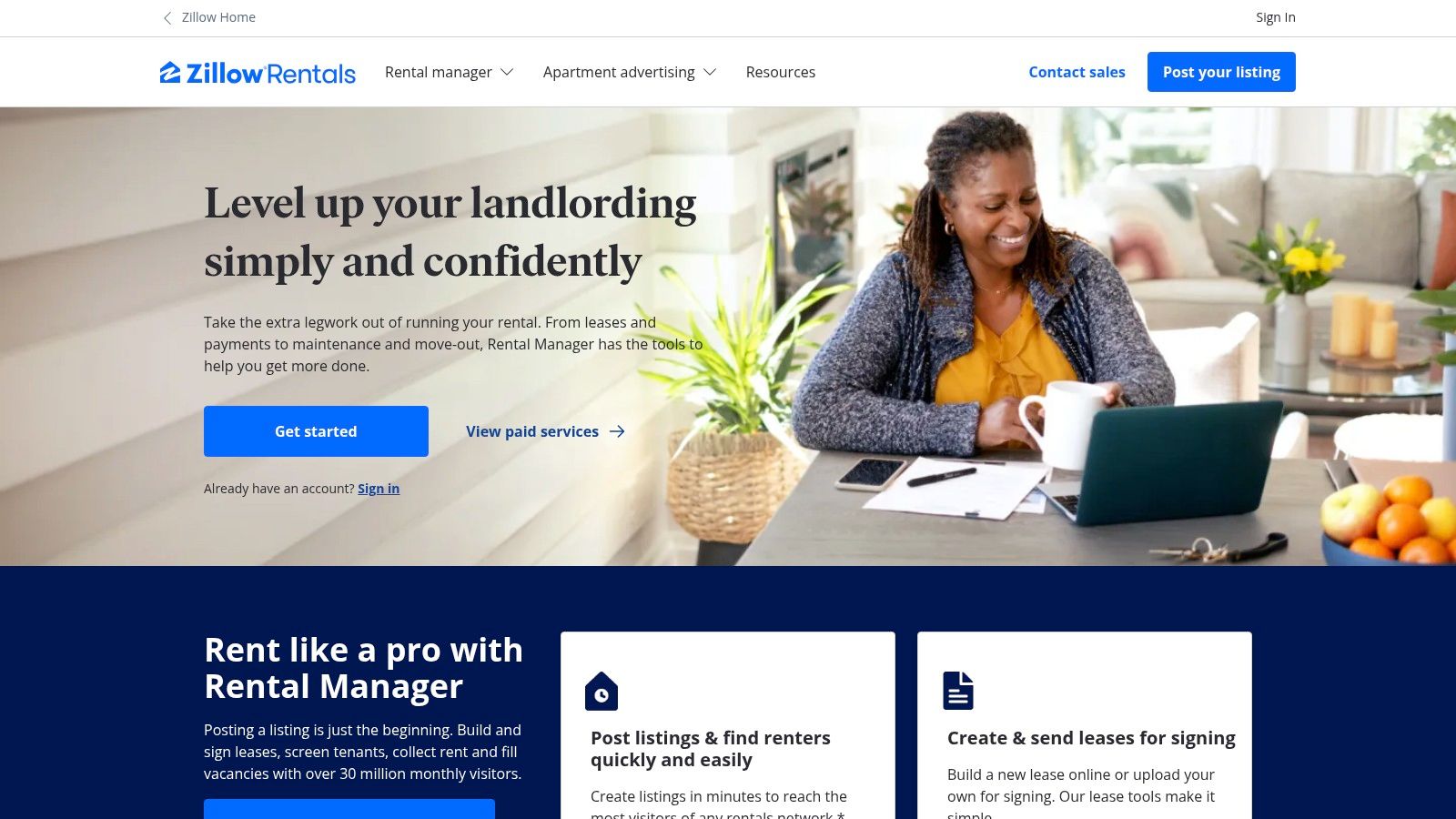
Its primary advantage is unparalleled listing syndication across the Zillow network, including Trulia and HotPads, putting your vacancy in front of a massive audience of active renters. This makes it one of the best software for landlords whose main goal is to reduce days on market (DOM) by maximizing lead flow.
Key Features & Use Cases
- Portfolio Type: Best for independent landlords with 1-10 units who prioritize filling vacancies quickly and need simple, free tools for basic management.
- Standout Feature: The platform’s core strength is its marketing engine. A single listing submission gets your property in front of millions of prospective tenants, a level of exposure that is difficult to achieve otherwise without significant ad spend.
- Pricing: The core service is free for landlords. This includes listing, receiving applications, and collecting ACH rent payments. Tenants pay for screening reports ($35 fee for credit and background checks). Premium listing upgrades are available for a cost to boost visibility.
Pros & Cons
Pros:
- Massive Renter Audience: Unmatched visibility for your rental listings across Zillow, Trulia, and HotPads significantly increases lead generation.
- Cost-Effective: The core tools are free for landlords, making it an excellent zero-cost entry point into property management software.
- Simple and Intuitive: The platform is easy to navigate, requiring minimal setup or technical expertise.
Cons:
- Limited Management Features: It lacks the advanced accounting, maintenance coordination, and robust reporting found in dedicated property management systems.
- Inconsistent Lease Features: The availability and features of the digital lease-building tool vary significantly by state law and jurisdiction.
Visit Zillow Rental Manager
12. Apartments.com Rental Manager
Best For: Independent landlords seeking powerful marketing reach and free core tools.
Apartments.com Rental Manager leverages its massive network to offer a compelling, free-to-use platform for independent landlords and those with small-to-mid-sized portfolios. It provides an impressive suite of core tools at no cost, covering the entire leasing lifecycle from syndicating listings across top rental sites to collecting rent online. This makes it one of the best software for landlords who need powerful marketing exposure without the high cost of enterprise systems.

The platform’s greatest strength is its seamless integration with the Apartments.com and Homes.com networks, instantly putting your vacancy in front of a vast audience of prospective renters. The workflow is intuitive, guiding a landlord from listing creation and tenant screening through digital lease signing and payment processing, all within a single, streamlined interface.
Key Features & Use Cases
- Portfolio Type: Best for DIY landlords and managers with 1-50 units who prioritize marketing reach and core functionality at a low cost.
- Standout Feature: The free, automatic listing syndication across the Apartments.com network is an unparalleled marketing tool for this price point, significantly reducing days on market by maximizing visibility.
- Pricing: The core platform is completely free for listing, applications, screening (paid by applicant), lease signing, and rent collection. Optional premium listings are available for a fee to boost visibility and get higher placement in search results.
Pros & Cons
Pros:
- Massive Renter Audience: Unmatched exposure through its network gets your properties seen by millions of potential tenants.
- Truly Free Core Tools: Essential features for the entire rental cycle are available without monthly fees or unit limits.
- Integrated Workflow: The platform smoothly connects listing, screening, leasing, and rent collection, simplifying the process for landlords.
Cons:
- Limited Advanced Features: Lacks the robust, portfolio-level accounting, reporting, and automation found in paid, professional-grade software.
- Upsells for Premium Placement: While listing is free, achieving top visibility for your property in competitive markets often requires paying for a premium listing.
Visit Apartments.com Rental Manager
Top 12 Landlord Software Feature Comparison
Building Your Scalable PropTech Stack to Drive Revenue
Navigating the landscape of property management technology reveals a critical truth for large-scale operators: selecting the single best software for landlords is a flawed approach. The real path to scalable success and revenue growth lies in strategically assembling an integrated PropTech stack. Your core Property Management System (PMS), whether it's an enterprise-grade solution like Yardi or a comprehensive platform like AppFolio, serves as the essential system of record for accounting, maintenance, and tenant data. However, relying on it alone leaves significant revenue on the table.
From All-in-One to Best-in-Class
The most sophisticated property management companies recognize that operational excellence is achieved by augmenting their core PMS with specialized, best-in-class solutions that target high-impact revenue levers. This is particularly true for the leasing lifecycle. While your PMS can handle applications and rent collection, it often falls short in optimizing the crucial, fast-paced phase from initial lead to a completed tour. This is where the most significant financial losses occur, measured in Days on Market (DOM).
Every day a unit sits vacant directly impacts your bottom line. To minimize this, you need a tool laser-focused on speed-to-lease. This involves automating lead response, offering instant and flexible tour scheduling, and standardizing the showing process across a distributed portfolio. A dedicated leasing automation platform like Showdigs integrates with your PMS to create a seamless workflow, transforming your leasing operations from a reactive, manual process into a proactive, revenue-generating engine.
Actionable Next Steps for Building Your Stack
To build a technology stack that truly scales, consider these steps:
Audit Your Current Leasing Funnel: Identify the biggest bottlenecks. Is it slow lead response times? Are you losing prospects due to limited showing availability? Calculate your current average lead-to-tour time and your DOM metrics. This data will be your baseline for measuring ROI.
Define Your Tiers of Need:
- Under 100 Doors: A single, comprehensive tool like TurboTenant or Avail might suffice to cover all your basic needs from listing to rent collection.
- 100-500 Doors: You’re entering the territory where a robust PMS like Buildium or DoorLoop becomes essential. At this stage, integrating a specialized tool for showings can begin to dramatically reduce DOM and administrative overhead.
- 500+ Doors: At this scale, a best-in-class strategy is non-negotiable. Your focus should be on an enterprise-grade PMS (AppFolio, Yardi) for core operations and a powerful leasing automation platform to optimize lead-to-tour conversion and standardize processes across multi-market portfolios.
Prioritize Integrations: The power of a PropTech stack comes from how well its components communicate. Ensure any new tool you adopt offers robust API integrations with your existing PMS. This prevents data silos and automates workflows, ensuring information flows seamlessly from lead capture in your leasing tool to lease signing in your PMS.
Ultimately, the right software stack empowers your team to move faster, operate more efficiently, and convert leads at a higher rate. It transforms property management from a series of manual tasks into a streamlined, scalable system designed to maximize portfolio value and drive revenue growth.
Ready to see how dedicated leasing automation can drastically reduce your Days on Market and optimize your lead-to-tour conversion rates? Learn how Showdigs integrates with your existing PMS to create a seamless, scalable showing operation that turns vacancies into revenue, faster. Schedule a demo today to calculate the potential ROI for your portfolio.




